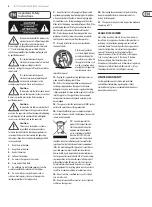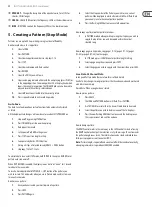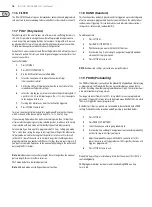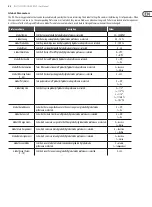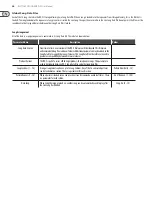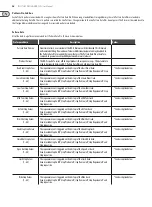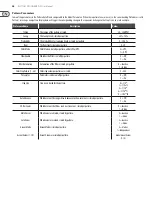
15
RHYTHM DESIGNER RD-9 User Manual
9. Wave Designer
Wave Designer is a powerful tool for adjusting signal transients and dynamics,
such as attack and sustain. Use the Wave Designer to make a snare drum really
“crack” in the mix, or to expand the bass drum to be even more devastating.
With both ATTACK and SUSTAIN controls set to 12 o’clock the Wave Designer
is essentially in bypass and will not affect any voices being sent to the Wave
Designer via the bus.
Adjusting the ATTACK knob will make the opening transient of the voice sound
punchier. Increasing the SUSTAIN control acts in a similar way as a compressor,
allowing the peaks to carry on longer before decay. The effect can also be used to
reduce the sustain for a more staccato sound.
NOTE:
Using a long sustain on naturally staccato sounds (i.e., Rim Shot) may
cause noise. Dial this noise out by reducing the sustain amount.
All voices sent to the Wave Designer as described will then pass into the Analog
Filter section to be processed.
The SIG LED shows that a signal is present in the Analog Filter/Wave Designer bus.
The SEND button activates the Wave Designer circuit.
How to assign voices to the FX bus:
1.
Press SEND in the FX sections (flashes orange).
2.
Use SELECT to assign which voices go to the bus (solid pink LED
indicates voice sent to the FX bus).
3.
Press SEND in the FX section to exit. SEND button will be
solid white to show voices are assigned to the FX bus.
TIP:
Hold TAP/HOLD while pressing SEND to clear all voice from the FX bus.
The diagram below shows the audio routing of the voices as they pass through
the RD-9. Only one voice is shown in this example, but the same process applies
to all voices.
10. Analog Filter
The Analog Filter (VCF) section works on selected sounds routed via an audio bus
fed from the Wave Designer circuit.
The CUTOFF control sets the frequency where the filter is applied. The filter cut off
can be programmed and automated (when the ON button is flashing, automation
is active).
When the HPF (High Pass Filter) button is engaged the filter cuts the the low
frequency cutoff point as you turn the control CW. When the HPF button is not
engaged, the CUTOFF knob defaults to a low-pass filter (LPF), which gradually
cuts the high frequencies as you turn the control CCW.
Press the ON button to activate the filter circuit.
The RESONANCE control adjusts the resonance of the filter. Turning CW adds a
peak at the cutoff frequency that accents the surrounding frequencies.
The filter CUTOFF control setting can be recorded as automation. After
programming a pattern, add the voice or voices you wish to be processed by the
Analog Filter and Wave Designer bus as described earlier in this manual. Next,
while the pattern is playing and in Record Mode, rotate the CUTOFF knob and
listen to the results. Once you are happy with your filter sweep exit Record Mode.
Next time you play the pattern, the recorded filter sweep will play back.
Live Filter Mode can be toggled on and off, and this toggling action gives you
either manual control of the filter frequency or automated Filter Mode, which
uses the stored filter automation data. The live Filter Mode can be toggled on and
off by holding the TAP/HOLD button and pressing the filter ON button to activate
different states:
• •
Flashing filter ON button= Filter plays stored automation data
• •
Solid filter ON button = Filter in live control mode
At any time, you can drop into Record Mode and adjust the filter settings that will
be stored with the current pattern, as long as the filter settings are set to Pattern
(see SETTINGS 11.5 below).
It is also possible to manually program the filter per step or to edit a recorded
filter sweep.
1.
Press SETTINGS.
2.
Press FILTER (STEP BUTTON 6).
3.
Pressing different step keys (1-64) will display the current filter
position from 0, turn the DATA control counterclockwise (CCW) to
255 turn clockwise (CW). Depending on which filter setting is in use,
HPF or LPF, the filter will be fully open or closed. Up to 64 steps can
be programmed using the <</>> keys in the LENGTH section to
navigate step position.
4.
Press SETTINGS twice to exit.
5.
Save PATTERN.
NOTE:
Filter automation will now carry across when extending / copying lengths
of patterns.
- turning the Cut Off control in play mode will end playing the automated Filter
mode.
- turning the Cut Off knob in record with Filter on will start recording the
automated Filter.
Содержание RD-9
Страница 38: ...We Hear You ...



